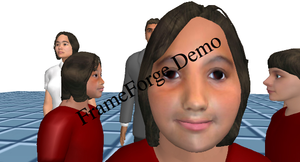Filmmaking Basics/Camera Lenses/Depth of field
|
Table of contents for All about camera lenses:

|
|
Unlimited depth of field
A extreme wide-angle lensThis is a 14mm lens for 35mm motion pictures, That is a very wide-angle lens. This lens can see 74 degrees of scenery (measured horizontally.) A wide angle lens has a huge depth of field. Even with a normal wide angle lens on a video camera, the depth of field is almost infinite. On a video camera with a super wide-angle adapter, the picture above is exactly what you would see. The glass on a video camera is so narrow, it acts like a pin hole camera which has an infinite depth of field. Therefore, on most video cameras, you cannot use depth of field to isolate one actor from the others. |
Limited depth of field
2.8 f-stopA wide-angle lens has little control over the depth of field. Yet, because a wide-angle lens accentuates distances so much, the effect of limited depth of field is larger that you might think. That is why you must always look through the actual lens to see the depth of field. It is too hard to predict just by using tables, etc.
|
|
Unlimited depth of field
A slight wide-angle lensThis is a 29mm lens for 35mm motion pictures which has a 40 degree view horizontal. Remember that the focal length (such as 29mm) is a function of the size of the film frame. Movie cameras, still film cameras, video cameras all have different frame sizes so you cannot compare focal lengths directly. Even the angle of view is measured differently. Still cameras measure the angle of sight across the diagonal, not the horizontal. |
Limited depth of field
|
|
Unlimited depth of field
|
Limited depth of field
2.8 f-stopSee how much better this shot looks which you limit the depth of field. You get this limited depth of field by opening up the lens to f2.8. Remember that a video camera has a small aperture so you will see an unlimited depth of field like the picture on the left. A typical video camera cannot give you the picture above. |
|
Unlimited depth of field
|
Limited depth of field
|
|
Unlimited depth of field
|
Limited depth of field
|
|
Unlimited depth of field
A extreme telephoto lensThis is a 180 mm lens for 35mm motion pictures which has a 7 degree view. Now the camera lens is so powerful, it clearly separates the actors without limiting the depth of field. What is not obvious is the camera has been more far away from the actors when you have a telephoto lens. Also any bounce in the camera will be magnified and look awful. |
Limited depth of field
|
|
Let's take a quick quiz
 The next page
Contact your instructor
|
















